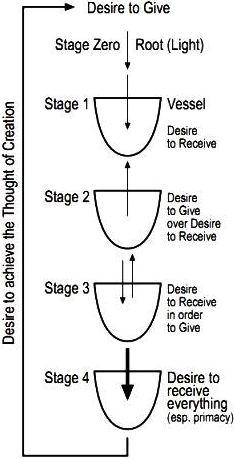
In “Preface to the Wisdom of Kabbalah,” Baal HaSulam divides the onset of Creation into five stages and one restriction, but we can cluster them into three groups. Think of the first two groups as a car and the fuel for its engine, and imagine that the third group is the driver.
The first group contains only Stage Zero, the Root. This is the desire to give, the energy that creates and sustains the car called “Creation.”
The second group—Stages One and Two—builds a “platform” for evolution. This is the car itself. In a sense, the platform that the two stages have built resembles what Richard Dawkins described in The Selfish Gene as “The primeval soup,” the oceanic substrate that contained the ingredients for life’s inception.
The third group—Stages Three and Four—is “the driver.” Its role is to start the engine of evolution—the interaction between the desires. As we will explain below and in the next chapter, the restriction is the wheel with which creation is driven toward its purpose: discovering the Thought of Creation.
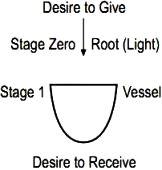
Stages Zero and One
In Kabbalistic terms, the existence of a desire to bestow without a desire to receive is called “the Root Stage” or “Stage Zero.” The Root Stage is immediately followed by its mandatory offshoot—“Stage One”—the desire to receive, which is permeated with the abundance given to it by the Root, the desire to bestow.
As a result, no element in existence, from subatomic particles to the most expansive galaxies in the universe, escapes the giving-receiving “bipartisanship.” It may appear in the form of hot vs. cold, dry vs. wet, small vs. big, centrifugal vs. centripetal, energy vs. matter, etc., but they all stem from the primordial opposites: giving and receiving.
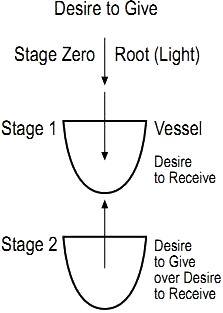
Stage Two
The result of the meeting between the two desires in Stage One is Stage Two. Here is where the actual interaction between the desires truly begins. To understand the shift that occurs between Stage One and Stage Two, consider a child’s admiration for its parents. Because children, especially in early childhood, idolize their parents, they strive to imitate them. They closely observe their parents’ every move (with a tendency for boys to observe their fathers and for girls to observe their mothers), “study” their parents’ demeanor, and try to follow suit.
Contemporary studies show how attentive children are to their parents’ guidance.
Also, Dr Benjamin Spock’s Baby and Child Care bestseller on parenting provides such a complete description of this process that I feel compelled to present it here in full: “Identification is a lot more important than just playing. It’s how character is built. It depends more on what children perceive in their parents and model themselves after than on what the parents try to teach them in words. This is how children’s basic ideals and attitudes are laid down—toward work, toward people, toward themselves … This is how they learn to be the kind of parents they’re going to turn out to be twenty years later, as you can tell from listening to the affectionate or scolding way they care for their dolls.”
And just as a child wishes to grow up to be like its parent, Stage Two in the evolution of the desire is an expression of the wish of the desire to receive (Stage One) to be like its parent—the desire to give (the Root). This happens because as it is a desire to receive—the “offspring” of the desire to give—Stage One recognizes the Root’s superiority and wishes to be like its progenitor. And because the only example that Stage One receives from the Root is that of giving, in Stage Two the desire to receive begins to want to give, as well.
Earlier, we said that at the basis of existence are forms of the desire to receive, created by interactions with their creator—the desire to give. Thus, through two natural, “automatic” reactions to giving, two opposite desires emerge: to receive (in Stage One), and to give (in Stage Two). The various combinations of these two desires form the basis of every object, every event, and every evolution that occurs in our world, including us—our bodies, our thoughts, and our actions.
Just as a child wishes to become like its role-model parent, at the root of the desire to give in Stage Two lies the desire to receive its progenitor’s superior status, power, and knowledge. In other words, Stage Two is a desire to receive the status and nature of giving. for this reason, it is best to picture Stage Two as a vessel (desire to receive) that wishes to give, or “vessel of bestowal.” Hence, the arrow designating this desire points outwards, toward the Creator.
But Stage Two is more than just a new desire. In wanting to give, Stage Two is admitted into an entirely new state of being. Because it no longer wishes to receive, but to bestow, it must have someone upon whom to bestow. Thus, to be like its creator—a giver—Stage Two must act positively and favorably toward others.
For this reason, Stage Two, the force that compels us to give despite our underlying desire to receive, is the force that makes life possible. Without it, parents would not have children (to whom they can bestow) or care for their offspring once they are born, life would not be possible.
Indeed, the best example of Stage Two is a mother’s love for her child. If we consider the endless love, compassion, and effort mothers put into raising their babies, we are left in awe and admiration that such devotion is even possible. Yet, when you look at a mother’s face while she is nursing, changing diapers, or bathing her baby, often you will find that she is glowing. Why is this so? What gives mothers the ability to not only endure such strain, but to wish for it and enjoy it?
The answer is simple, and every mother knows it instinctively: In giving to their babies, they experience tremendous joy. There is a desire to receive the pleasure of motherhood (or parenthood) behind every decision to bring a new life into the world. Without it, people would not have babies, unless by mistake, and this would be very unfortunate for the children.
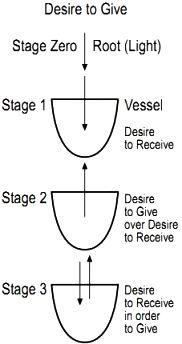
Stage Three
As Ashlag stated, the evolution of desires, which hang down by cause and effect, is mandatory, adhering to fixed, determined rules. The next mandatory step is for Stage Two to start giving, since this is what it wants to do. But in Stage Two the newly made desire to give has a problem to solve: it wishes to give, but all that exists besides itself (the desire to receive with its two stages) is the desire to give that created it. Therefore, the only thing that Stage Two can give to its creator is its willingness to receive. In other words, it will receive, just as in Stage one, but with the intention to give pleasure to the Root—the Creator. This “inverted” modus operandi, where the act is reception but the intention is to give, is a completely new concept and hence merits a new name—“Stage Three.”
It may seem awkward to some, but we apply this mode of action routinely in our relationships. Think of a young man who comes to visit his mother after not having seeing her for a long time. It is quite likely that his mother will want to prepare something to eat for her darling son. But what if the son is not very hungry? Will he not eat? In most cases, he will eat and express his delight at the food simply because it pleases his mother.
In this case, the son is not focused on his own pleasure, but on his mother’s pleasure in watching him eat. In “Preface to the Wisdom of Kabbalah,” Baal HaSulam describes this mode of work as partial use of the desire to receive, just the necessary minimum for the reception of pleasure, while maintaining the center of attention on the giver’s delight at the receiver’s acceptance. In our culinary example, the son must have some appetite or he will not be able to eat at all. However, his appetite should not be big enough to shift his intention (or attention) from pleasing his mother to pleasing himself.
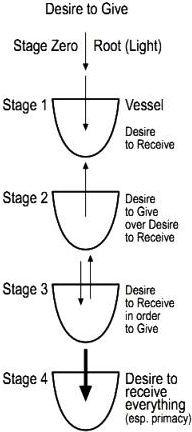
Stage Four
When the son’s appetite is mild enough to be subordinate to his desire to please his mother, he can focus on his intention to please, rather than on his stomach. But what if he were very hungry and had not eaten for a whole day? Would he still be able to ignore his rumbling stomach, focus only on his mother’s pleasure, and eat only because it pleases her? When Stage Three begins to receive because it wishes to please the Root, it realizes that the more it receives, the more it pleases its maker, the Root.
In consequence, it begins to wish to receive more and more and more. finally, it wishes to receive everything, just as in Stage one, thus reawakening the whole of its desire to receive. This self-evoked total desire to receive is called “Stage four.”
What Is the Difference between Stage One and Stage Four?
Yet, there is a fundamental difference between Stage One and Stage Four: relation to the giver. Stage One does not relate to the giver, only of the abundance. As soon as it “realizes” there is the desire to give that created it, it wishes to be like the giver, and this initiates Stage Two. Stage Four is realizes not only the giver’s existence, but also of the giver’s benevolence and primacy, since it is the desire to give that initiated creation. And being a complete desire to receive, Stage four wishes to receive not just the abundance that Stage one receives, but the primacy status of the Root.
However, to receive such a status, Stage Four must be Creator-like, and it is not. Instead, it is a conscious desire to receive everything—omnipotence, omniscience, and even the nature of the Creator. Anything less than that would be incomplete, since it would not be precisely identical to the Creator. This is what Ashlag means when he writes in “Preface to the Wisdom of Kabbalah” that Stage Four wishes to achieve the Thought of Creation.
In another essay, “The Giving of the Torah [Light],” Ashlag offers a beautiful explanation of the nature of the Creator-created relationship that occurs at the outset of Creation: “This matter is like a rich man who took a man from the market and showered him with gold, silver, and all desirables each day. And each day he gave him more gifts than the day before. finally, the rich man asked, ‘Do tell me, have all your wishes been fulfilled?’ He [the man] replied, ‘Not all of my wishes have been fulfilled, for how good and how pleasant it would be if all those possessions and precious things came to me through my own work, as they have come to you. Then I would not be receiving the charity of your hand.’ Then the rich man told him, ‘In this case, there has never been born a person who could fulfill your wishes.’”
Thus, when Stage Four realizes it cannot obtain the Root’s primacy, it realizes that it cannot receive everything and that it is inherently inferior to its maker. This instantly extinguishes any sensation of pleasure in Stage four, and despite the infinite abundance that the Root gives, Stage Four remains with a sense of emptiness, since its biggest wish has not been granted. In Kabbalah, when Stage Four’s desire to be like its maker overshadows all other pleasures, it is called “restriction.” Because the desire to be like the Creator is so much greater than all other desires, it practically prevents pleasure from being experienced.
From here on, evolution will unfold in a single underlying purpose: to repossess that great abundance that the Root wishes to give, and which can be received only with the intention to bestow.
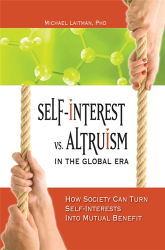 “What Are the Four Developmental Stages of the Primordial Desire in Creation?” is based on the book, Self Interest vs. Altruism in the Global Era: How Society Can Turn Self Interests into Mutual Benefit by Dr. Michael Laitman.
“What Are the Four Developmental Stages of the Primordial Desire in Creation?” is based on the book, Self Interest vs. Altruism in the Global Era: How Society Can Turn Self Interests into Mutual Benefit by Dr. Michael Laitman.

Thank you
For your lesson is of great value..
Thank you. I want to be a Holy soul for the Creator. As I cleave to Him, in devotion, truth faith, and love.